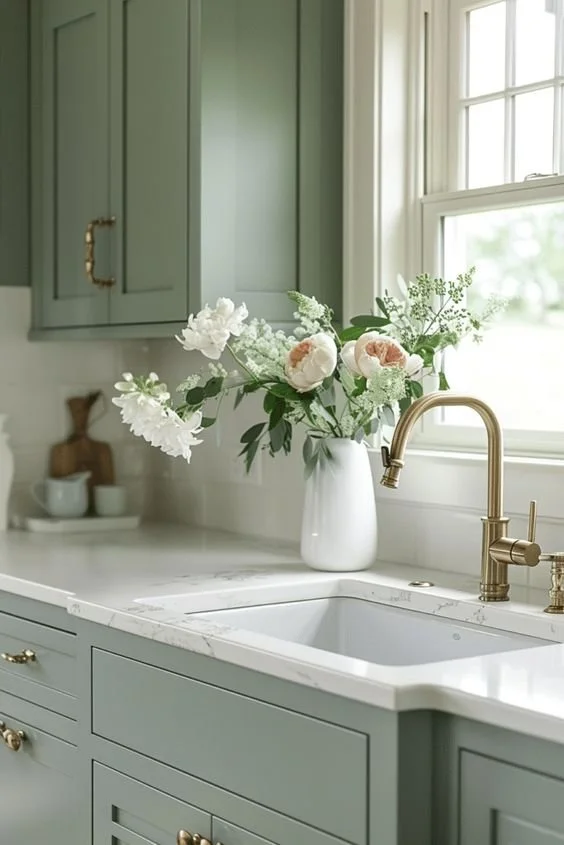ADHD Girl’s Guide to Kitchen Design: Creating a Functional and Focused Space
Designing a kitchen that suits the needs of someone with ADHD can make a significant difference in daily life.
A well-organised, sensory-friendly kitchen can help reduce overwhelm, improve focus, and make meal prep a breeze.
From simple layout choices to colour schemes that foster calm, this ADHD Girl’s Guide to Kitchen Design will walk you through the steps to creating a space that works with your brain, not against it. Let’s dive in!
1. ADHD kitchen design tip #1: Simplify the Layout for Easy Flow
For ADHD brains, kitchen chaos can quickly lead to frustration and distraction. One of the best ways to combat this is by creating a streamlined and simple layout that makes it easy to stay organised.
Tip 1: The Triangle Rule
Stick to the classic work triangle (sink, stove, fridge) to minimise distractions and keep everything within easy reach. A cluttered space with too many zones can be overwhelming, so aim for clear, dedicated areas for cooking, prepping, and storing.
Tip 2: Visual Storage Solutions
Open shelving can be a lifesaver for ADHD brains that need visual cues to stay organised. Glass-fronted cabinets or floating shelves allow you to see what you have at a glance, reducing decision fatigue and making it easier to grab what you need. Just be mindful of not overcrowding these shelves to avoid visual overwhelm.
Tip 3: Declutter the Countertops
Minimising countertop clutter is crucial for staying focused. Choose built-in storage for appliances, and only keep essential items like a kettle or coffee maker out. This keeps your kitchen tidy and makes it easier to clean, which can help reduce sensory overload.
2. ADHD kitchen design tip #2: Use Calming, Sensory-Friendly Colours
For those with ADHD, overstimulating colours can create unnecessary distractions. The key is to design a space that promotes calmness and focus through a carefully chosen colour palette.
Tip 1: Go for Muted Tones
Colours like soft blues, muted greens, and gentle neutrals can create a soothing environment, helping you feel more relaxed while cooking. Avoid bright, bold colours like red or yellow, which can overstimulate the senses.
Tip 2: Contrast for Organisation
While keeping the colours calm, use contrast in subtle ways to organise your kitchen. For instance, have your cabinetry in a soft colour like sage green and your counters in a darker tone like grey or black. This will help you visually differentiate spaces without overwhelming your senses.
Tip 3: Avoid Too Many Patterns
ADHD brains can struggle with too much visual stimulation, so it’s best to limit bold patterns in your kitchen. If you do want to add some texture or pattern, try a simple, calming backsplash in a monochrome or muted pattern.
We design functional, thoughtful,
and beautiful homes, fit for real life.
At FBD Interiors, our main focus is creating spaces that are both elevated and realistic for your lifestyle. And we walk through every step of the process right alongside you - whether it’s a room refresh, a new kitchen, or a full home makeover/build.
We design functional, thoughtful, and beautiful homes, fit for real life.
3. ADHD kitchen design tip #2: Maximise Functionality with Smart Storage
Staying organised in the kitchen is essential for reducing decision fatigue and making meal prep more manageable. Smart storage solutions can help you keep everything in its place, making it easier to find what you need and stay focused.
Tip 1: Drawer Dividers and Pull-Out Shelves
Invest in drawer dividers, pull-out shelves, and organisers to keep utensils, spices, and pantry items neatly arranged. This will help you avoid that dreaded “junk drawer” effect and ensure everything has its own place. It also makes cleaning up much quicker, which is key for ADHD brains that can lose interest halfway through tidying.
Tip 2: Label Everything
Labelling is a great way to create structure in the kitchen. Whether it’s food containers, spice jars, or pantry baskets, clearly marked labels can prevent confusion and make it easy to find things at a glance. Bonus: It can also save you from buying unnecessary duplicates!
Tip 3: Use Clear Storage Containers
Clear storage containers for pantry staples like pasta, rice, and flour can help you keep track of your inventory, ensuring that you don’t run out of essentials or overbuy. They also make it easier to see what you have without rummaging through a cluttered cabinet.
Designing a kitchen that works for someone with ADHD requires a focus on simplicity, calm, and functionality. By creating an uncluttered layout, choosing sensory-friendly colours, and incorporating smart storage solutions, you can design a kitchen that minimises distractions and helps you stay focused.
Remember, a kitchen that works with your brain can make a world of difference in your day-to-day life.
If you’re ready to transform your kitchen into an ADHD-friendly haven, get in touch with us today. We’ll help you create a space that’s not only stylish but also designed to support your unique needs.




